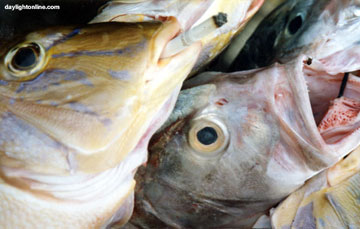Aquaculture key to seafood crisis
Aquaculture key to seafood crisis
mongabay.com
February 16, 2007
A scientific panel at the American Association for the Advancement of Science annual meeting in San Francisco Friday revealed that rising demand for seafood has exceeded the capacity of the marine ecosystem and that expansion of aquaculture will need to continue to help meet consumer appetite for seafood products.
The panel — which included Dr. Steven Otwell (University of Florida), Dr. Randy MacMillan (National Aquaculture Association), Dr. Richard Langan (University of New Hampshire Open Ocean Aquaculture Program), Dr. Shaun Moss (Oceanic Institute in Hawaii), Dr. Scott LaPatra (Clear Springs Foods, Inc.), Dr. Craig Tucker (Mississippi State University), and Dr. Ron Hardy (University of Idaho) — discussed the “potential for sustainable growth of healthy farmed seafood production” through recent “advancements in feed efficiency and the ability to expand production in marine environments” according to a news release from the National Fisheries Institute.
“At a time when heart disease kills one American every 35 seconds and the overall health benefits of consuming seafood are evident, it is essential to educate the public about increasing their consumption of a lean protein such as fish,” said Dr. Otwell, also a member of National Academy of Sciences’ Seafood Safety Committee. “To meet the growing demand for healthy seafood, we absolutely must embrace and expand aquaculture.”
|
|
“Aquaculture is the fastest growing food supply in the world,” notes the National Fisheries Institute. “According to the UN Food and Agriculture Organization, global aquaculture production will need to nearly double by the year 2050 to meet consumer demand.”
In the United States alone, aquaculture sales exceeded $1 billion in 2005 according to the U.S. Department of Agriculture. While an estimate 80% of fish stocks are harvested at sustainable levels here in the U.S., Americans’ voracious demand for seafood means that large quantities are imported from overseas, pressuring marine stocks there. Presently, over 70 percent of the seafood eaten in the U.S. is imported and “at least 40 percent of those imports come from aquaculture farms.”
“Whether from fresh or marine waters, be it catfish or cod, farmed seafood allows greater numbers of Americans to enjoy the health benefits of fish in an environmentally-friendly way,” said Dr. MacMillan, president of the National Aquaculture Association and AAAS panel organizer. “Aquaculture is a relief valve’ that takes the pressure off wild capture fisheries and helps promote sustainability of the natural ecosystem.”
The panel reviewed a number of new techniques designed to make aquaculture more sustainable and healthier for consumers.
“In the U.S., we now are at a crossroads; it is up to us to build a viable infrastructure for marine aquaculture and grow healthy fish here at home. Seafood farming in the open ocean is a frontier with enormous potential, but it also poses obstacles. Research efforts in our program have yielded extraordinary results, and future exploration will move us closer to increased commercial establishment of these farms.”=
This article is based on a news release from the National Fisheries Institute.
